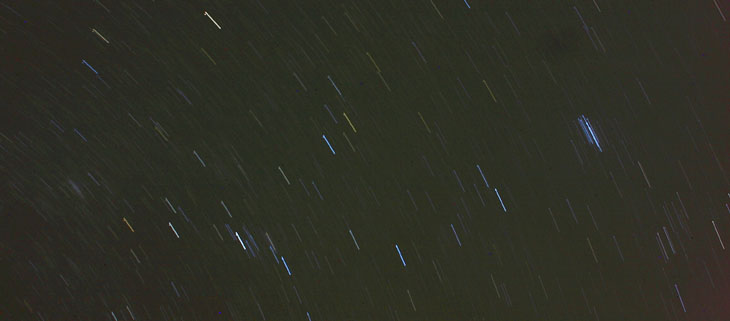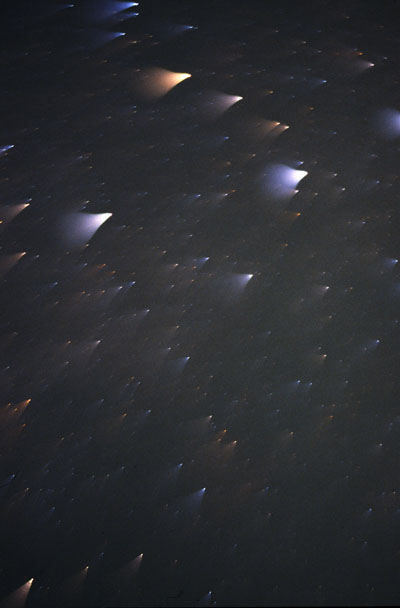I actually got out last night for the Leonids meteor shower, braving the cold like a dedicated nature photographer… well, okay, to a small extent, anyway. I was unable to travel very far, so it meant trying to find a darker sky spot in an area not particularly known for it. The cities aren’t big around here, but they’re spaced just right to mean traveling a long distance to get away from light pollution effectively. My choice last night was an area largely screened by trees, and aiming north towards the most rural areas.
While I managed to spot a few meteors, I don’t think I captured any on film. And yes, I mean literally on film (though not literally captured – oh, never mind) since I was using both the digital SLR and the Mamiya 645 medium format camera. I’ve had much better luck with film for astrophotography, since it produces more color and is less prone to noise for long exposures, but we’ll have to wait a bit to see what I might have gotten – the few meteors I spotted probably fell outside the view of the 45mm lens (which is a nice, wide angle on 6×4.5 film, roughly equivalent to a focal length of 24mm on film cameras – why are we still calling them “35mm”? – and about 15mm on DSLRs.)
The five frames I got on digital showed no telltale streaks except from aircraft, which were still far too busy when I was out after 11 PM – this is kind of a north/south airway region. “Five frames?” you say (go ahead, don’t leave me hanging.) But yes, the point of meteor photography is that you’re never going to capture anything if you wait until you see it to trip the shutter, because they’re visible typically less than a second, so you lock open the shutter and just wait for something to cross your field of view. I was doing exposures between five and fifteen minutes with the digital, and the ambient air temperature was 2°C (36°F,) so both sets of batteries died out after an hour. Had I seen more than three meteors, I might have continued a little longer with the Mamiya, but I figured I was cold enough for the sparse activity last night. There was frost on the tripod legs as I packed it in.

That is pretty much my luck with meteor showers. Most happen to fall on evenings with poor visibility, regardless of how long we might have gone with crystal skies leading up to the showers. When we do get clear skies, the activity is pathetic. With one exception.
In 2001 I had just moved to Georgia, and on the evening of the Leonids, I spotted a spectacular airburst, resembling a crashing plane, on the drive home – on the interstate, by a brightly lit exit, from inside the car. It would have been awesome in a dark-sky location. So I poked around until I found a nice dark location and spent most of the early morning out there. It was a fabulous night, and I was maintaining a count of all the meteors I was seeing directly – glimpses and corner-of-the-eye didn’t count. In the first hour I was over two dozen, having shattered my old personal record of thirteen for one night when living in central New York, where the skies were quite dark and I often walked at night. By 4 AM when I was about to wrap it up, I spotted twenty just in the time it took me to pack up the camera and tripod, convincing me that the peak was coming and I should probably hang around a bit longer. That morning, I stopped counting at three hundred clearly seen, with an unknown number glimpsed, all in about five hours.
One in particular was spectacular, burning parallel to the horizon and lighting up the entire sky, fragmenting and leaving multiple trails (I checked the next day to be sure the ISS hadn’t re-entered by accident.) Even more interesting was when I realized that the tree in my field of view was flickering, indicating some light coming from behind me and suggesting I was missing a similar light show back there.
Now, the sad confession: I have no photos of this whatsoever. Well, I have most of a roll of film that I shot that night, but I wasn’t stocked up and what I had handy was Kodak Portra 400 left over from a wedding. ISO 400 is a nice speed for night photography, fairly light-sensitive and color-responsive yet not too grainy to make things ugly, but Portra 400 is an exception because of a little something called reciprocity failure. Welcome to advanced film properties.
Reciprocity is the photography function that ties together aperture, shutter speed, and ISO, and basically means you can change any of these settings by a given amount, and change either of the other two in the opposite direction by the same amount (called the reciprocal,) and get the same exposure. So you can get very fast shutter speeds if you can open your aperture far enough – the reduction of light from the shutter is compensated by the additional light through the lens. In the realm of low light photography like at night, you can compensate by leaving the shutter open for long periods of time, and can make a moonlit scene appear to be daylight if you wait long enough.
 Reciprocity failure is where this breaks down. Due to the nature of the chemical reaction to light, low amounts of light don’t always register on film, and so lengthening the exposure has a reduced effect, with diminishing returns depending on the amount of light and length of exposure, often with a color shift because the different layers of emulsion have different sensitivities. Some films, like Fuji Provia 100, handle this fairly well, but Kodak Portra 400 is not among them. The images I have from that evening are all blue, grainy, and show almost no stars at all, much less meteor streaks. For the best opportunity I’ve ever had, I totally blew the pics. Even the spectacular airburst, which might have overcome the film’s flaws, was well away from the direction the camera was aimed at the time.
Reciprocity failure is where this breaks down. Due to the nature of the chemical reaction to light, low amounts of light don’t always register on film, and so lengthening the exposure has a reduced effect, with diminishing returns depending on the amount of light and length of exposure, often with a color shift because the different layers of emulsion have different sensitivities. Some films, like Fuji Provia 100, handle this fairly well, but Kodak Portra 400 is not among them. The images I have from that evening are all blue, grainy, and show almost no stars at all, much less meteor streaks. For the best opportunity I’ve ever had, I totally blew the pics. Even the spectacular airburst, which might have overcome the film’s flaws, was well away from the direction the camera was aimed at the time.
And sometimes that’s how it goes (or at least it does for me.) The cool stuff happens when you’re not in a position to exploit it, and when you’re prepared, it’s quiet. Last night was hardly a shower, or even a trickle. One of these days I’ll capture a decent meteor storm, but in the meantime, I’ll experiment with lens tricks like this one. Bonus points if you can tell me how it was done ;-)
Later on, I’ll provide a quick tutorial on eradicating noise caused by bad sensor pixels from your digital images. Some Photoshop tricks are actually quite useful.




















































